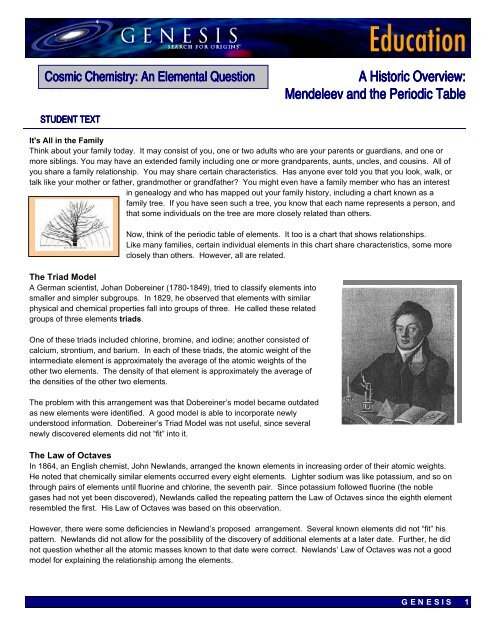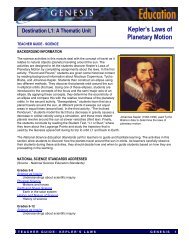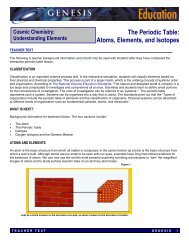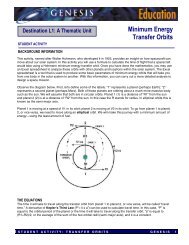A Historic Overview: Mendeleev and the Periodic Table - Genesis
A Historic Overview: Mendeleev and the Periodic Table - Genesis
A Historic Overview: Mendeleev and the Periodic Table - Genesis
You also want an ePaper? Increase the reach of your titles
YUMPU automatically turns print PDFs into web optimized ePapers that Google loves.
Cosmic Chemistry: An Elemental QuestionA <strong>Historic</strong> <strong>Overview</strong>:<strong>Mendeleev</strong> <strong>and</strong> <strong>the</strong> <strong>Periodic</strong> <strong>Table</strong>STUDENT TEXTIt's All in <strong>the</strong> FamilyThink about your family today. It may consist of you, one or two adults who are your parents or guardians, <strong>and</strong> one ormore siblings. You may have an extended family including one or more gr<strong>and</strong>parents, aunts, uncles, <strong>and</strong> cousins. All ofyou share a family relationship. You may share certain characteristics. Has anyone ever told you that you look, walk, ortalk like your mo<strong>the</strong>r or fa<strong>the</strong>r, gr<strong>and</strong>mo<strong>the</strong>r or gr<strong>and</strong>fa<strong>the</strong>r? You might even have a family member who has an interestin genealogy <strong>and</strong> who has mapped out your family history, including a chart known as afamily tree. If you have seen such a tree, you know that each name represents a person, <strong>and</strong>that some individuals on <strong>the</strong> tree are more closely related than o<strong>the</strong>rs.Now, think of <strong>the</strong> periodic table of elements. It too is a chart that shows relationships.Like many families, certain individual elements in this chart share characteristics, some moreclosely than o<strong>the</strong>rs. However, all are related.The Triad ModelA German scientist, Johan Dobereiner (1780-1849), tried to classify elements intosmaller <strong>and</strong> simpler subgroups. In 1829, he observed that elements with similarphysical <strong>and</strong> chemical properties fall into groups of three. He called <strong>the</strong>se relatedgroups of three elements triads.One of <strong>the</strong>se triads included chlorine, bromine, <strong>and</strong> iodine; ano<strong>the</strong>r consisted ofcalcium, strontium, <strong>and</strong> barium. In each of <strong>the</strong>se triads, <strong>the</strong> atomic weight of <strong>the</strong>intermediate element is approximately <strong>the</strong> average of <strong>the</strong> atomic weights of <strong>the</strong>o<strong>the</strong>r two elements. The density of that element is approximately <strong>the</strong> average of<strong>the</strong> densities of <strong>the</strong> o<strong>the</strong>r two elements.The problem with this arrangement was that Dobereiner’s model became outdatedas new elements were identified. A good model is able to incorporate newlyunderstood information. Dobereiner’s Triad Model was not useful, since severalnewly discovered elements did not “fit” into it.The Law of OctavesIn 1864, an English chemist, John Newl<strong>and</strong>s, arranged <strong>the</strong> known elements in increasing order of <strong>the</strong>ir atomic weights.He noted that chemically similar elements occurred every eight elements. Lighter sodium was like potassium, <strong>and</strong> so onthrough pairs of elements until fluorine <strong>and</strong> chlorine, <strong>the</strong> seventh pair. Since potassium followed fluorine (<strong>the</strong> noblegases had not yet been discovered), Newl<strong>and</strong>s called <strong>the</strong> repeating pattern <strong>the</strong> Law of Octaves since <strong>the</strong> eighth elementresembled <strong>the</strong> first. His Law of Octaves was based on this observation.However, <strong>the</strong>re were some deficiencies in Newl<strong>and</strong>’s proposed arrangement. Several known elements did not “fit” hispattern. Newl<strong>and</strong>s did not allow for <strong>the</strong> possibility of <strong>the</strong> discovery of additional elements at a later date. Fur<strong>the</strong>r, he didnot question whe<strong>the</strong>r all <strong>the</strong> atomic masses known to that date were correct. Newl<strong>and</strong>s’ Law of Octaves was not a goodmodel for explaining <strong>the</strong> relationship among <strong>the</strong> elements.G E N E S I S 1
<strong>Mendeleev</strong>In <strong>the</strong> mid-1800s, most chemists worldwide were convinced that <strong>the</strong> elements existed in families that had similar physical<strong>and</strong> chemical properties. However, <strong>the</strong>re was no widely accepted chart that explained relationships in chemicalproperties among chemical groups. The periodic table, an information organizing tool that we take for granted today,began as a simple question in <strong>the</strong> mind of a Russian scientist, Dmitrii I. <strong>Mendeleev</strong> (1843-1907). What is <strong>the</strong> relationshipof <strong>the</strong> elements to one ano<strong>the</strong>r <strong>and</strong> to <strong>the</strong> chemical families to which <strong>the</strong>y belong?<strong>Mendeleev</strong>'s passion for underst<strong>and</strong>ing <strong>the</strong> families of elements took him into previouslyuncharted territory. He felt that <strong>the</strong> newly understood atomic mass measurementswould have greater significance once scientists clearly understood <strong>the</strong> relationshipsamong <strong>the</strong> elements. <strong>Mendeleev</strong> wrote his ideas into <strong>the</strong> chemistry textbooks fromwhich he taught. In Principles of Chemistry, published in 1869, <strong>Mendeleev</strong> introduced aconcept he called <strong>the</strong> <strong>Periodic</strong> Law that stated:The properties of <strong>the</strong> elements are a periodic function of <strong>the</strong>ir atomic weights.He subsequently published several versions of a periodic table of <strong>the</strong> elements, including all elements known at thattime. How was <strong>Mendeleev</strong> able to chart <strong>the</strong> relationships among <strong>the</strong> 63 known elements? It all started in a game ofcards.A Game of CardsIn order to underst<strong>and</strong> <strong>the</strong> properties of <strong>the</strong> known elements <strong>and</strong> <strong>the</strong>ir relationships to one ano<strong>the</strong>r, <strong>Mendeleev</strong>developed a card game. He wrote out <strong>the</strong> properties of each element on a different card <strong>and</strong> spent a great deal of timearranging <strong>and</strong> rearranging <strong>the</strong>m. He was looking for patterns or trends in <strong>the</strong> data on <strong>the</strong> cards. His friends called thisgame “Patience.”<strong>Mendeleev</strong> first arranged all <strong>the</strong> cards from lowest to highest atomic mass. The lightest element known in <strong>Mendeleev</strong>’stime was hydrogen. Its properties were not like any o<strong>the</strong>r known element. So <strong>Mendeleev</strong> decided to leave it out of hisgame.Scientists who are initially struggling to underst<strong>and</strong> a large mass of data commonly ignore, at least for a time, those datapoints that seem too different from <strong>the</strong> o<strong>the</strong>rs. These unusual instances are termed outliers. Whe<strong>the</strong>r or not outlierscan eventually be explained by a model often makes or breaks <strong>the</strong> scientific <strong>the</strong>ory from which <strong>the</strong> model derives.The second lightest element known to <strong>Mendeleev</strong> was lithium.HWe now know that <strong>the</strong> second lightest element, betweenhydrogen <strong>and</strong> lithium, is helium. But helium was notdiscovered on earth until 1895.So <strong>Mendeleev</strong> started his game with <strong>the</strong> element lithium.LiBeBCNOFG E N E S I S 2
In order of increasing atomic mass, <strong>Mendeleev</strong> thought about <strong>the</strong> elements beryllium, boron, carbon, nitrogen, oxygen,<strong>and</strong> fluorine. These elements were all different in <strong>the</strong>ir physical <strong>and</strong> chemical properties, thus seeming to belong todifferent families. <strong>Mendeleev</strong> put <strong>the</strong>ir cards in a vertical row, with lithium at <strong>the</strong> top <strong>and</strong> fluorine at <strong>the</strong> bottom.LiBeBVNOFNaThe known element next most massive after fluorine was sodium. It shared many physical<strong>and</strong> chemical properties with lithium. They seemed enough alike to be classified asbelonging to <strong>the</strong> same family. Thus <strong>Mendeleev</strong> put sodium’s card as <strong>the</strong> top of a secondcolumn, just to <strong>the</strong> right of lithium’s card.From <strong>the</strong>re things worked amazingly well. <strong>Mendeleev</strong> was thinking about <strong>the</strong> similarproperties of <strong>the</strong> next elements. Magnesium, following sodium, had physical <strong>and</strong>chemical properties similar to beryllium, which followed lithium. In <strong>the</strong> same manner,<strong>Mendeleev</strong> placed aluminum next to boron; silicon next to carbon; phosphorus next tonitrogen; sulfur next to oxygen; <strong>and</strong> chlorine next to fluorine.<strong>Mendeleev</strong> must have felt great pleasure in how this card game was turning out.Repeating patterns are called periodic. <strong>Mendeleev</strong> eventually called this arrangement<strong>the</strong> periodic table of <strong>the</strong> elements.LiBeBVNOFNaMgAlSiPSClLi Na KBe Mg CaB AlC SiN PO SF ClLi Na KBe Mg CaB AlC Si TiN PO SF ClProblems <strong>and</strong> Predictions<strong>Mendeleev</strong> encountered <strong>the</strong> first problem with his model in <strong>the</strong> next set of elements.Potassium headed <strong>the</strong> third column, since its properties were similar to those of sodium<strong>and</strong> lithium. Calcium was next, <strong>and</strong> it fit well with magnesium <strong>and</strong> beryllium.The next known element was titanium. According to <strong>Mendeleev</strong>’s model, it shouldhave belonged to <strong>the</strong> same chemical family as boron <strong>and</strong> aluminum. But titanium’sproperties were similar to those of silicon.Li Na KBe Mg CaB Al ??Ti?C SiN PO SF Cl<strong>Mendeleev</strong> did not give up. He decided to puttitanium in <strong>the</strong> row with carbon <strong>and</strong> silicon. He left agap next to boron <strong>and</strong> aluminum. He predicted that an unknown element would someday be found with an atomic mass between 40 (for calcium) <strong>and</strong> 48 (for titanium),whose properties would be similar to those of boron <strong>and</strong> aluminum.In fact, in 1878 <strong>the</strong> element sc<strong>and</strong>ium was discovered. Its atomic mass was almost45, <strong>and</strong> it had properties as predicted by <strong>Mendeleev</strong>.G E N E S I S 3
<strong>Mendeleev</strong> continued laying down his cards <strong>and</strong> felt comfortable identifying two more gaps or “missing” elements in <strong>the</strong>fourth column, in <strong>the</strong> third <strong>and</strong> fourth rows. His genius is shown in his ability to recognize <strong>the</strong> potential for missing data<strong>and</strong> to use existing data to predict <strong>the</strong> properties of <strong>the</strong>se unknown elements. <strong>Mendeleev</strong> left spaces on his periodictables because he did not "force" <strong>the</strong> known elements to fit any preconceived pattern. The absence of elements withcertain physical <strong>and</strong> chemical properties also indicated that not all existing elements had yet been discovered.<strong>Mendeleev</strong> interpolated from what he knew to make predictions about what was missing. These predictions guided <strong>the</strong>search for o<strong>the</strong>r elements.<strong>Mendeleev</strong> not only suggested that elements similar to aluminum <strong>and</strong> silicon should exist. He predicted severalproperties of "ekasilicon". “Eka” means “first,” “beyond,” or “after” in Greek.<strong>Mendeleev</strong> thought ekasilicon would have a specific gravity of 5.5, <strong>and</strong> its oxide would have a specific gravity of 4.7. Hewas right on both counts. These values are close to those eventually found for germanium. Gallium (similar to aluminum)<strong>and</strong> germanium (similar to silicon) were discovered in 1871 <strong>and</strong> 1886, respectively.Prediction of Properties of an Unknown ElementEkasiliconGermaniumAtomic weight 72 72.32Specific gravity 5.5 5.47Color dark grey greyish-whiteFormula of oxide EsO2 GeO2Specific gravity of oxide 4.7 4.70Formula of chloride EsCl4 GeCl4Specific gravity of chloride 1.9 1.887Boiling point of chloride below 100°C 83°C<strong>Mendeleev</strong> focused on <strong>the</strong> chemical properties of <strong>the</strong> elements. He concluded that certain commonly accepted valuesfor atomic masses were incorrect. He calculated that <strong>the</strong> atomic mass of chromium would be greater than <strong>the</strong> valuebeing used at that time. Although <strong>the</strong>re was a place in <strong>the</strong> table for chromium between calcium <strong>and</strong> titanium based on<strong>the</strong> incorrect value for its atomic weight, <strong>the</strong> properties of chromium did not fit with this placement.By 18 71 , M en de le e v ha d m od if i ed a n d im pr o ve d his f ir st pe r io di c tab le of t he el em e nt s. He use d it s or g an i za ti on ofi nf or m a t io n to pr ed i ct t h e exist en ce of t en el em e nt s ( n o w kn o wn a s Sc, G a, G e, T c, R e, Po, F r , Ac, <strong>and</strong> Pa) . He fu ll yd escr ib e d in gr ea t det ai l f ou r of th e se ( Sc, G a, G e, a nd Po) . H e d id th is b y i nt e r p ol at i ng i n fo r m at i on f r om w ha t w as kn ow n.<strong>Mendeleev</strong> became world famous because of his development of <strong>the</strong> periodic table of <strong>the</strong>elements. He traveled throughout Europe, visiting with o<strong>the</strong>r famous scientists. However,<strong>Mendeleev</strong> was a political liberal. Czar Alex<strong>and</strong>er II, who ruled Russia in <strong>the</strong> late 1800s, didnot approve of <strong>Mendeleev</strong>. Therefore, <strong>Mendeleev</strong> was never recognized by being electedto <strong>the</strong> Russian Academy of Sciences. However, <strong>Mendeleev</strong> was honored posthumously in1955 when Mendelevium, manmade element number 101 in <strong>the</strong> modern periodic table, wasnamed for him.101 258MdMendeleviumConclusionThe periodic table that hangs in many classrooms <strong>and</strong> laboratories today has a 130 year history. It is <strong>the</strong> family tree of<strong>the</strong> elements. Although Dimitri <strong>Mendeleev</strong>'s periodic table is certainly not <strong>the</strong> only chart that organizes elements basedon <strong>the</strong>ir properties, his table was <strong>the</strong> first to illustrate <strong>the</strong> periodic relationship between chemical groups. This table is atool that fur<strong>the</strong>rs underst<strong>and</strong>ing of <strong>the</strong> chemistry of <strong>the</strong> elements. From <strong>Mendeleev</strong>'s <strong>Periodic</strong> Law <strong>and</strong> his determinationto find some order to <strong>the</strong> characteristics of <strong>the</strong> elements, scientists have been able to proceed with <strong>the</strong>ir scientificinquiries in a logical <strong>and</strong> systematic manner.G E N E S I S 4













